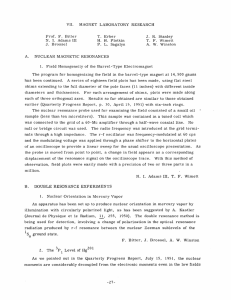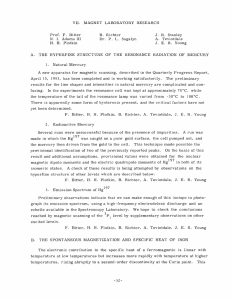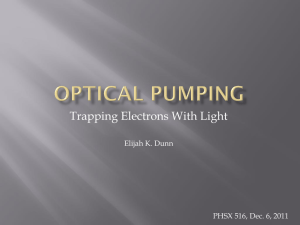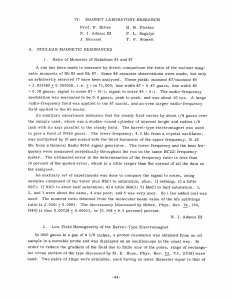VII. MAGNET LABORATORY RESEARCH J. R. Stanley
advertisement
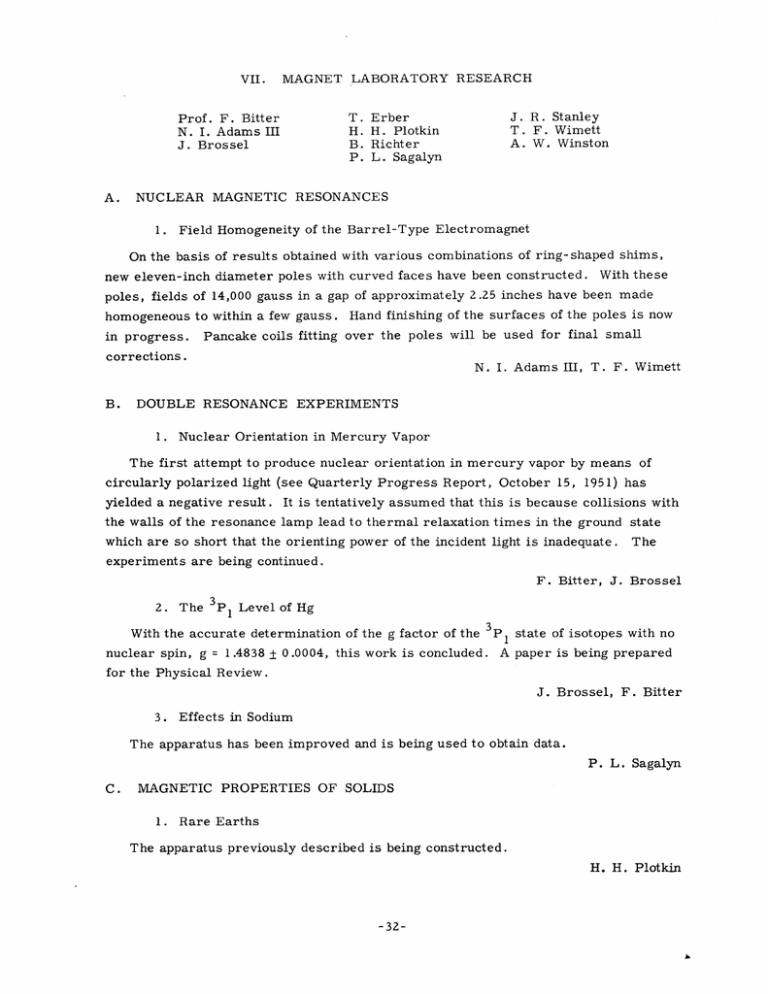
VII. MAGNET LABORATORY RESEARCH T. H. B. P. Prof. F. Bitter N. I. Adams III J. Brossel A. J. R. Stanley T. F. Wimett A. W. Winston Erber H. Plotkin Richter L. Sagalyn NUCLEAR MAGNETIC RESONANCES 1. Field Homogeneity of the Barrel-Type Electromagnet On the basis of results obtained with various combinations of ring-shaped shims, With these new eleven-inch diameter poles with curved faces have been constructed. poles, fields of 14,000 gauss in a gap of approximately 2.25 inches have been made homogeneous to within a few gauss. in progress. Hand finishing of the surfaces of the poles is now Pancake coils fitting over the poles will be used for final small corrections. Wimett N. I. Adams III, T. F. B. DOUBLE RESONANCE EXPERIMENTS 1. Nuclear Orientation in Mercury Vapor The first attempt to produce nuclear orientation in mercury vapor by means of circularly polarized light (see Quarterly Progress Report, yielded a negative result. October 15, 1951) has It is tentatively assumed that this is because collisions with the walls of the resonance lamp lead to thermal relaxation times in the ground state which are so short that the orienting power of the incident light is inadequate. The experiments are being continued. F. 2. The 3P 1 Bitter, J. Brossel Level of Hg With the accurate determination of the g factor of the 3P nuclear spin, g = 1.4838 + 0.0004, this work is concluded. 1 state of isotopes with no A paper is being prepared for the Physical Review. J. 3. Brossel, F. Bitter Effects in Sodium The apparatus has been improved and is being used to obtain data. P. C. MAGNETIC L. Sagalyn PROPERTIES OF SOLIDS 1. Rare Earths The apparatus previously described is being constructed. H. H. Plotkin -32- (VII. 2. MAGNET LABORATORY RESEARCH) Diamagnetism of Metals in Weak Fields The torsion balance previously described was found to be inadequate. A device similar to that described by Plotkin, which promises to be more sensitive, is being constructed. J. D. R. Stanley THE ZEEMAN EFFECT IN ATOMIC HYDROGEN The Zeeman effect in hydrogen in a field of 80,000 gauss has been photographed, using the Balmer series lines originating on levels with n = 6, 7, results so far have been on the last of these lines. 8, and 9. The best A densitometer trace showing the ao components and the central no-field line is reproduced in Fig. VII- 1. The magnitude of the quadratic diamagnetic shift may be estimated by noting the computed position, shown as a dotted line, omitting quadratic corrections. Fig. VII-1 Density trace of Zeeman pattern in hydrogen at 7.97 x 104 gauss showing Position of o- comrelation of a- components and no-field line (3835A°). ponents, if there were no quadratic shift, is shown by broken lines. The comparison of these results with theory is complicated by the fact that the line used results from a combination of S--P, P- S, and D -P transitions; it will be given when more complete experimental results are available. T. Erber, B. Richter -33-
